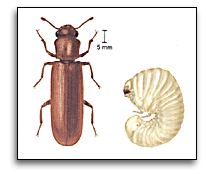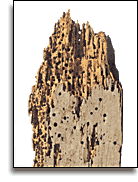 This
small 1/6 to ? inch - 4 to 6 mm cylindrical beetle is reddish brown and
has punctures on the dorsum in longitudial rows. The last three segments
of the antennae are longer than the others. The lavra is creamy - white
with dark brown mandibles. It has also got a double row of spines on the
dorsum.
This
small 1/6 to ? inch - 4 to 6 mm cylindrical beetle is reddish brown and
has punctures on the dorsum in longitudial rows. The last three segments
of the antennae are longer than the others. The lavra is creamy - white
with dark brown mandibles. It has also got a double row of spines on the
dorsum. Infestations
of beetles can be recognized by the small round holes which appear in hardwood
floors, furniture, molding and fixtures as well as by the presence of fine
dust (frass). The frass may fall from the emergence holes and accumulate
in small piles.
Infestations
of beetles can be recognized by the small round holes which appear in hardwood
floors, furniture, molding and fixtures as well as by the presence of fine
dust (frass). The frass may fall from the emergence holes and accumulate
in small piles.Fumigation usually provides immediate control of all life stages within the wood. However this method provides no residual insecticide for long term protection against reinfestation.
The application of a liquid insecticide to the surface of infested wood may not provide immediate control of feeding larvae. However, the residual qualities of a liquid insecticide application provide control by killing larvae and adults emerging through tread surfaces. The residual activity of a liquid insecticide can also provide protection against reinfestation.